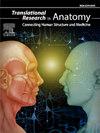An analytical study of the greater palatine foramen in adult human skulls using anatomical planes for clinical considerations
Q3 Medicine
引用次数: 0
Abstract
Background
The greater palatine nerve, a branch of the maxillary nerve, enters the oral cavity through the greater palatine foramen (GPF). Accurate localization of the GPF is essential while negotiating the greater palatine canal to block the maxillary nerve within the pterygopalatine fossa.
Objective
This study aimed to elucidate the shape, orientation, and position of the greater palatine foramen in relation to the surgically encountered anatomical landmarks and maxillary molars in an adult Indian population.
Methods
The study was conducted on 80 human adult skulls of unknown gender. Both sides of the hard palate were assessed, and the number of GPF was recorded by direct visual inspection. Morphometric measurements were recorded with regard to the topographic relation of GPF with the neighbouring bony landmarks. The data were analysed using an independent sample t-test and Spearman rank correlation to check the relationships between the measurements.
Results
The average distance from the incisive fossa to the posterior nasal spine was 40.68 mm. The distance between GPF and incisive fossa was 40.68 and 36.32 mm on the right and left sides, respectively. The distance between GPF and lesser palatine foramen was 2.99 and 2.81 mm on the right and left sides, respectively.
Conclusion
The present study provides additional metrical values that help locate the GPF accurately. The data presented here will also provide an index for future studies and help with various invasive procedures in the field of dentistry.
用解剖平面分析成人颅骨腭大孔的临床意义
背景:腭大神经是上颌神经的一个分支,通过腭大孔进入口腔。当通过腭大管阻断翼腭窝内的上颌神经时,GPF的准确定位至关重要。目的探讨印度成年人群中腭大孔的形状、方向和位置与外科解剖标志和上颌磨牙的关系。方法对80个性别不详的成人颅骨进行研究。评估双侧硬腭,直接目测记录GPF数。形态学测量记录了GPF与邻近骨骼地标的地形关系。数据分析使用独立样本t检验和Spearman秩相关来检查测量之间的关系。结果鼻尖窝距鼻后棘的平均距离为40.68 mm。GPF与左、右侧锐窝的距离分别为40.68 mm和36.32 mm。GPF与腭小孔的左右距离分别为2.99 mm和2.81 mm。结论本研究提供了额外的测量值,有助于准确定位GPF。本文所提供的数据也将为未来的研究提供一个索引,并对牙科领域的各种侵入性手术提供帮助。
本文章由计算机程序翻译,如有差异,请以英文原文为准。
求助全文
约1分钟内获得全文
求助全文
来源期刊

Translational Research in Anatomy
Medicine-Anatomy
CiteScore
2.90
自引率
0.00%
发文量
71
审稿时长
25 days
期刊介绍:
Translational Research in Anatomy is an international peer-reviewed and open access journal that publishes high-quality original papers. Focusing on translational research, the journal aims to disseminate the knowledge that is gained in the basic science of anatomy and to apply it to the diagnosis and treatment of human pathology in order to improve individual patient well-being. Topics published in Translational Research in Anatomy include anatomy in all of its aspects, especially those that have application to other scientific disciplines including the health sciences: • gross anatomy • neuroanatomy • histology • immunohistochemistry • comparative anatomy • embryology • molecular biology • microscopic anatomy • forensics • imaging/radiology • medical education Priority will be given to studies that clearly articulate their relevance to the broader aspects of anatomy and how they can impact patient care.Strengthening the ties between morphological research and medicine will foster collaboration between anatomists and physicians. Therefore, Translational Research in Anatomy will serve as a platform for communication and understanding between the disciplines of anatomy and medicine and will aid in the dissemination of anatomical research. The journal accepts the following article types: 1. Review articles 2. Original research papers 3. New state-of-the-art methods of research in the field of anatomy including imaging, dissection methods, medical devices and quantitation 4. Education papers (teaching technologies/methods in medical education in anatomy) 5. Commentaries 6. Letters to the Editor 7. Selected conference papers 8. Case Reports
 求助内容:
求助内容: 应助结果提醒方式:
应助结果提醒方式:


